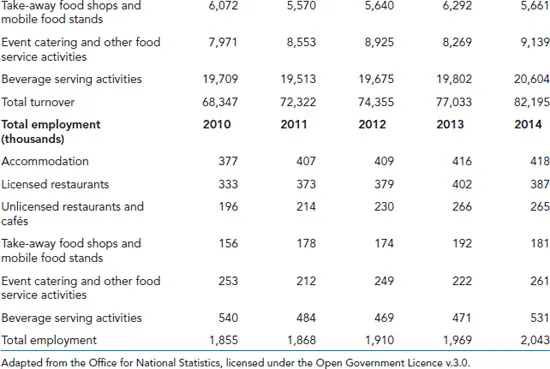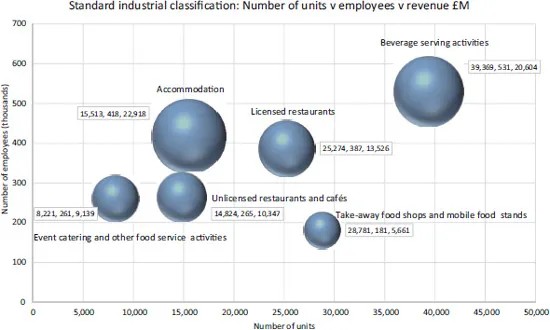![]()
Chapter 1
Introducing food and beverage management
Chapter objectives
After working through this chapter, you should be able to:
- Understand the complexity of the hospitality industry.
- Identify the size and scope of food and beverage operations.
- Distinguish between market and cost orientation.
- Identify the key responsibilities of food and beverage managers and the constraints that may be placed on them.
- Explain the factors affecting the nature of the meal experience and recognize the manager’s role in ensuring coherence.
Introduction
The provision of food and beverages away from home forms a substantial part of the activities of the hospitality industry and, indeed, of the economy as a whole. Like the industry of which it is a major part, food and beverage operations are characterized by their diversity. Outlets include private and public sector establishments and range from small, independently owned and operated units to large multi-national corporations managing global brands, and from prison catering to catering in the most luxurious hotels in the world.
It is, however, very difficult to get hold of consistent statistics about the hospitality industry and about food and beverage operations, as there is no one single definition of what the boundaries of the various industry sectors and sub-sectors are and therefore what should and should not be included.
Activity 1
Before you go any further with this chapter, write down eight different occasions when you might eat out of the home and attach a different example of business you might use to each occasion. For example, taking my girl/boyfriend out to celebrate their birthday – The Ivy; popping into town at lunchtime for a sandwich and a coffee – Pret A Manger, and so on.
Size and scope of food and beverage operations
If the hospitality industry is considered to cover all undertakings concerned with the provision of food, drink and accommodation away from home, this will naturally include all food and beverage outlets. In other words, food and beverage provision is simply one element of a broader hospitality industry. In conceptual terms, this raises few problems except possibly with take-away food establishments, where in some cases the food may be taken home for consumption even though it is prepared and provided away from home. In practice, however, there are a number of difficulties in considering the hospitality industry as embracing all food and beverage establishments and outlets. This arises because, following a number of official and commercial attempts at definition, the hospitality industry is often considered to have a much narrower scope. The official definitions have excluded many food and beverage outlets. For example, the Standard Industrial Classification (CSO, 1992) gives hospitality a reasonably broad coverage, as shown in Table 1.1, but even here parts of employee and welfare catering are either omitted or included in other sectors. This book adopts the broadest possible approach, aiming to consider all types of food and beverage operation wherever they may appear.
Table 1.1 Size and scope of the hospitality industry
Table 1.1 provides the latest figures from 2014 on the size and scope of the UK hospitality industry available from UK government sources. The figures are based on the definitions in the Standard Industrial Classification 2007, shown in full in Table 1.2. The data show a pattern of fairly consistent growth across most sectors of the industry for the first five years of the decade from 2010.
In terms of the number of businesses, in the five years since 2010 the industry has grown by just over 3%. However, this overall growth hides significant differences between sectors. The unlicensed restaurants and cafés sector, including coffee shops such as Starbucks, Costa and Pret A Manger, has grown by just under 25%, with event catering and other food service growing the number of enterprises by nearly 15%. Licensed restaurants, take-away food shops and the accommodation sector have grown between 8% and 3%, but the beverage serving sector, including pubs and clubs, has seen the number of enterprises fall by over 12.5%. In particular, the number of wet-led pubs, where most of the revenue comes from alcoholic beverages, has seen a very high number of closures.
Looking at turnover provides a slightly different picture of the make-up of the total of over £82,000 million. Again, it is the unlicensed restaurant and cafés sector that has shown the most growth, with an increase of almost a third since 2010. The accommodation and licensed restaurant sectors have also performed well, seeing a rise of around a quarter, but it must be remembered that the revenue for the accommodation sector includes bedroom sales as well as food and drink sales, and this may well be where the majority of growth has come from. Event catering and other food service saw a 14.5% growth in the number of enterprises but only a 13% growth in turnover. This could suggest a saturated market where more businesses are competing for a reasonably static market. While the pub sector saw a nearly 13% growth in the number of enterprises, their revenue has grown by over 4%. This suggests either a consolidation of the sector with a smaller number of larger businesses, or that each business, now more likely to be food-led, is showing much better sales performance. The reality is probably somewhere between the two. The only sector to see a decline in turnover is the take-away sector. This sector has been affected by the growth of eating at home and home delivery services, such as Deliveroo, which deliver from many high street brands as well as traditional take-aways.
In employment terms, the industry now employs over two million people, a growth of almost 10% in the last five years. Despite the decline in numbers of pubs, this sector still employs more people than any other at just over half a million. The second largest sector is accommodation, but again, this carries the warning that it also includes employees outside the scope of the food and drink departments. Once again, the highest growth has been in the coffee shop sector, which has added around 26% more employees in five years.
Activity 2
From the previous discussion and Table 1.1, which sector of the industry do you consider to be the most important and why?
Consider the comparison presented in Figure 1.1. Does this change your opinion?
Figure 1.1 Comparison of industry sectors
Standard industrial classification
The figures given above come from the UK government and are based on the Standard Industrial Classification, 2007. For analytical purposes, economically similar activities may be grouped together into ‘industries’, for example into agriculture, motor vehicle manufacture, retail distribution, catering and national government service. A system used to group activities in this way is described as an ‘industrial classification’. Such a classification usually starts with a small number of broad groups of activities that are then subdivided into progressively narrower groups so that the classification can be used with varying amounts of detail for different purposes.
The first comprehensive Standard Industrial Classification (SIC) for the United Kingdom was issued in 1948. The classification has been revised on many occasions, and in order to comply with EU data standards, the SIC was redrawn in 2007 and the new classification scheme came into effect at the beginning of 2008. While the old SIC had only four main groups – hotels and other accommodation; restaurants, cafés and take-aways; pubs bars and clubs; and canteens and contract catering – the new scheme as shown in Table 1.2 is much more comprehensive. There is a lot of information here, but it is worth looking at the various headings in some detail to understand the differences between the different classifications.
Table 1.2 UK Standard Industrial Classification of Economic Activities 2007 | SECTION I ACCOMMODATION AND FOOD SERVICE ACTIVITIES This section includes the provision of short-stay accommodation for visitors and other travellers and the provision of complete meals and drinks fit for immediate consumption. The amount and type of supplementary services provided within this section can vary widely. This section excludes the provision of long-term accommodation as primary residences, which is classified in real estate activities (section L). Also excluded is the preparation of food or drinks that are either not fit for immediate consumption or that are sold through independent distribution channels, i.e. through wholesale or retail trade activities. The preparation of these foods is classified in manufacturing (section C). 55 ACCOMMODATION This division includes the provision of short-stay accommodation for visitors and other travellers. Also included is the provision of longer term accommodation for students, workers and similar individuals. Some units may provide only accommodation while others provide a combination of accommodation, meals and/or recreational facilities. This division excludes activities related to the provision of long-term primary residences in facilities such as apartments typically leased on a monthly or annual basis classified in Real Estate (section L). 55.1 Hotels and similar accommodation This class includes the provision of accommodation, typically on a daily or weekly basis, principally for short stays by visitors. This includes the provision of furnished accommodation i... |



